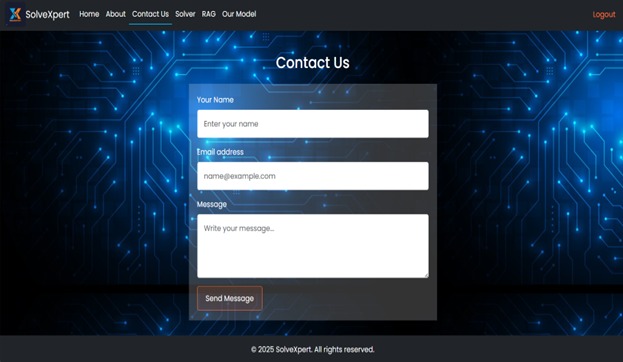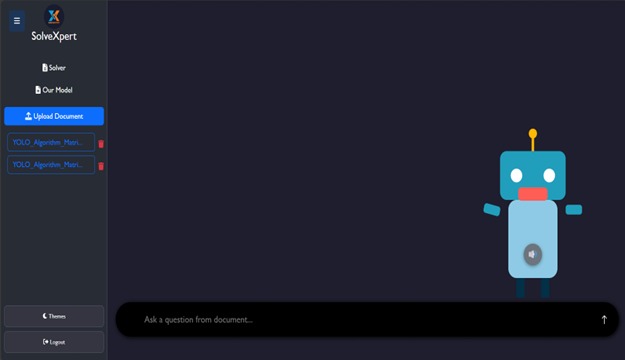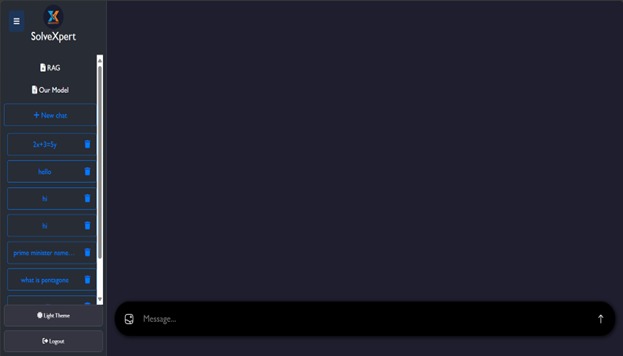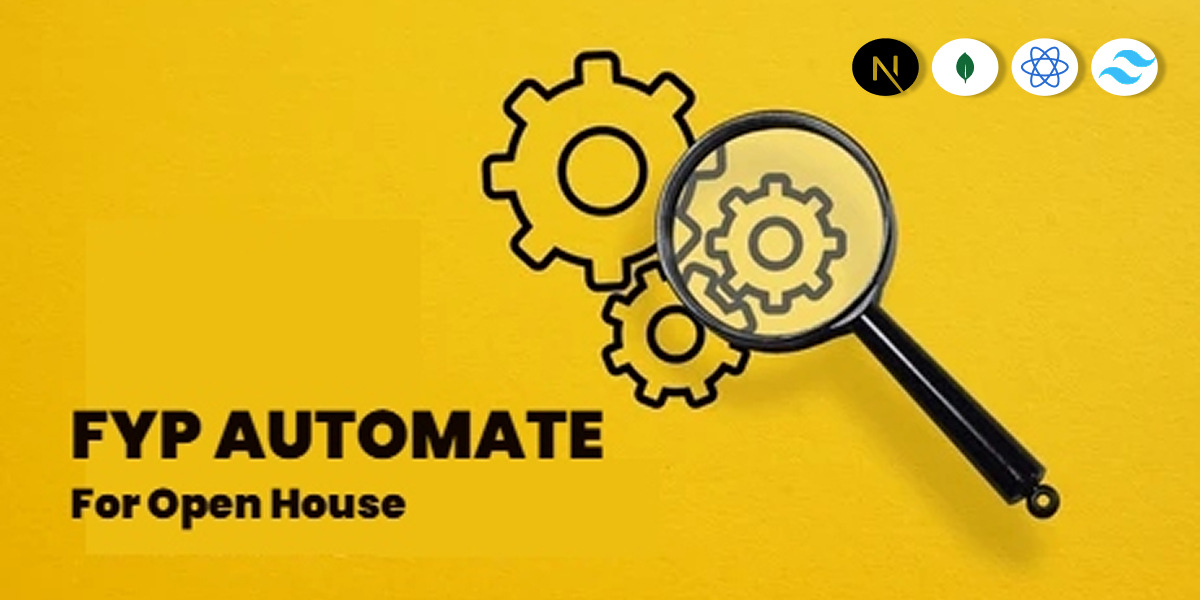Objectives
The primary objective of 'AI-SolveXpert' is to develop an AI-powered web platform that enhances mathematics learning through intelligent question answering, document-based Q\&A, and immersive user interaction. The system aims to make math more accessible and engaging for students by offering step-by-step problem solutions and voice-enabled explanations through an avatar, making it ideal for both visual and auditory learners.
The platform offers two core functionalities:
1. 'Math Problem Solving' using a fine-tuned AI model accessed through a FastAPI backend. Users can type queries directly or upload images containing math problems. The OCR engine (Pytesseract) extracts the text, and the model returns a detailed explanation of the solution.
2. 'Document-Based Q\&A' using Retrieval-Augmented Generation (RAG). Users can upload textbooks, notes, or research papers. ChromaDB stores the document embeddings, enabling users to ask context-based questions and receive accurate, AI-generated answers. Each response is also converted to speech using a TTS engine for better understanding.
Key objectives include:
* Implementing secure user authentication via Mailer for login, signup, and password reset.
* Allowing personalized user sessions with chat history and memory context.
* Delivering a seamless, responsive UI developed in Django with support for light/dark theme toggling.
* Providing an interactive avatar that speaks answers, offering a human-like experience.
* Supporting accessible learning via image upload (for handwritten or printed math problems) and audio output.
Overall, the system aims to revolutionize traditional learning by integrating NLP, OCR, and speech synthesis technologies to create a smarter, more interactive tutoring experience for students.
Socio-Economic Benefit
The development and deployment of 'AI-SolveXpert' offer significant socio-economic benefits, particularly in the education and technology sectors. This platform addresses educational accessibility, enhances personalized learning, promotes digital literacy, and contributes to broader economic development by integrating advanced AI technologies into a practical, student-friendly solution.
From a social perspective, the platform empowers students by providing them with an interactive, self-paced learning environment. Many students struggle with mathematics due to a lack of access to quality tutoring or hesitation in asking questions in class. 'AI-SolveXpert' reduces this barrier by allowing students to learn anonymously and comfortably at their own pace. The avatar-based responses and voice-enabled explanations further help auditory and visually inclined learners, including those with mild learning disabilities, to grasp concepts more effectively.
By supporting both typed and image-based inputs, including handwritten problems, the platform enables inclusivity for students who may not be proficient in typing or those studying from physical textbooks. The voice output generated by text-to-speech also aids students with reading difficulties, helping to promote equitable learning experiences.
In rural or underserved areas where qualified math instructors are limited, 'AI-SolveXpert' can serve as a virtual learning assistant, reducing dependency on physical infrastructure and helping bridge the digital divide. With just a device and an internet connection, students can receive high-quality assistance that mimics expert-level guidance.
Economically, this project contributes to the growing EdTech sector by offering a cost-effective alternative to traditional tutoring or coaching centers. The AI-driven model reduces the need for constant human intervention, allowing it to scale efficiently across schools, colleges, and e-learning platforms. Its modular architecture also enables future commercial integration with learning management systems, increasing its market potential and economic value.
Additionally, the project promotes technological upskilling among developers and students by incorporating modern tools such as FastAPI, ChromaDB, Django, and OCR technologies. This encourages the adoption of AI in academic environments and fosters innovation within local tech communities.
In conclusion, 'AI-SolveXpert' not only democratizes access to quality education but also supports inclusive learning, encourages self-study habits, reduces educational costs, and contributes to the digital transformation of the education sector—making it a socially impactful and economically scalable solution.
Methodologies
The development of 'AI-SolveXpert' followed a structured and iterative software engineering approach to ensure that all functional and non-functional requirements were addressed effectively. The methodology adopted for this project is a hybrid of the 'Agile' and 'Incremental' development models, enabling continuous improvement, modular delivery, and flexibility in handling changing requirements.
The project began with the 'Requirement Gathering' phase, where functional expectations such as math solving, image-based OCR, document-based Q\&A, text-to-speech response, user authentication, and chat history management were documented. Inputs were collected through literature reviews, peer interviews, and research into existing AI-based education platforms.
Following this, the 'System Design' phase focused on translating requirements into architectural plans. A modular design approach was used to divide the system into distinct components: user interface, backend logic, model interaction layer, document embedding system (RAG), and the avatar/voice module. UML diagrams such as use case, class, and deployment diagrams were prepared to illustrate system functionality and interactions between components.
During the 'Implementation Phase', each module was developed independently using an incremental strategy. The frontend was built using Django templating, with a focus on responsive UI and theme toggling. For backend services, Django handled user interactions, authentication, and database logic, while FastAPI was used to interact with the fine-tuned AI model. ChromaDB was integrated for RAG-based document querying, and pytesseract was employed for OCR in the solver page. Audio responses were generated using a TTS engine and synchronized with an animated avatar to provide engaging feedback.
To manage development progress, 'Agile sprints' were used. Weekly milestones and mini-deliverables ensured that each functionality—such as login/signup, image OCR, model API, and voice avatar—was developed, reviewed, and refined before moving to the next stage. This allowed flexibility in adapting to new ideas, fixing issues early, and improving performance through feedback loops.
'Testing' was conducted in parallel with development. Unit testing validated backend modules, functional testing ensured page-specific workflows operated correctly, and interface testing verified user interactions. Bugs were tracked using a shared log, and each test case was documented for traceability. Final integration testing ensured that all components worked seamlessly together.
Lastly, 'Documentation' was maintained throughout the lifecycle. This included requirement specs, design diagrams, API flowcharts, usage guides, and user manuals. Upon project completion, a full demonstration was prepared along with a detailed final report.
Outcome
The outcomes of the 'AI-SolveXpert' project reflect the successful design, development, and deployment of a feature-rich, AI-powered educational platform aimed at enhancing the mathematics learning experience. The system integrates advanced technologies such as Large Language Models (LLMs), Retrieval-Augmented Generation (RAG), OCR (Optical Character Recognition), Text-to-Speech (TTS), and secure authentication into a seamless web-based interface.
One of the most significant outcomes is the development of a working 'Model Page' that allows users to submit math-related queries directly and receive step-by-step solutions from a fine-tuned AI model. This feature was successfully integrated using FastAPI to bridge the frontend with the backend model. Users can interact with the model in real-time, making the experience efficient and personalized.
The 'Solver Page' extends this functionality by enabling users to upload math problem images. With the help of the pytesseract OCR engine, the platform accurately extracts the text from images, which is then processed through the Gemini Flash 2 model. This enables the platform to support handwritten or printed math inputs, making it useful for students learning from physical notes or books.
The 'RAG Page' allows users to upload entire documents such as textbooks, research papers, or notes. These documents are embedded using ChromaDB, and the system supports asking context-aware questions. The integration of ChromaDB ensures that the AI can respond with precise answers derived from user-uploaded content, making the system highly adaptable to various learning materials.
A standout feature of the platform is the use of a voice-enabled avatar that reads out solutions. This not only improves accessibility for students with reading challenges but also enhances overall engagement. The TTS module successfully converts AI-generated responses into audio, which is synchronized with an animated avatar for a human-like interaction.
Another key outcome is the secure and reliable user authentication system built using Mailer. It supports email-based signup, login, and password recovery, ensuring data security and user-specific session management. The system also retains chat history for each user, maintaining continuity in learning sessions.
The UI supports both light and dark themes, which enhances usability and user comfort. All core functionalities were thoroughly tested through unit, functional, and interface testing phases to ensure robustness and correctness.
In summary, 'AI-SolveXpert' has achieved its goals by delivering a complete AI-driven web application that combines educational value, user-friendly design, and advanced backend intelligence. The platform is scalable, modular, and adaptable, making it an ideal solution for students seeking personalized and interactive math assistance.









